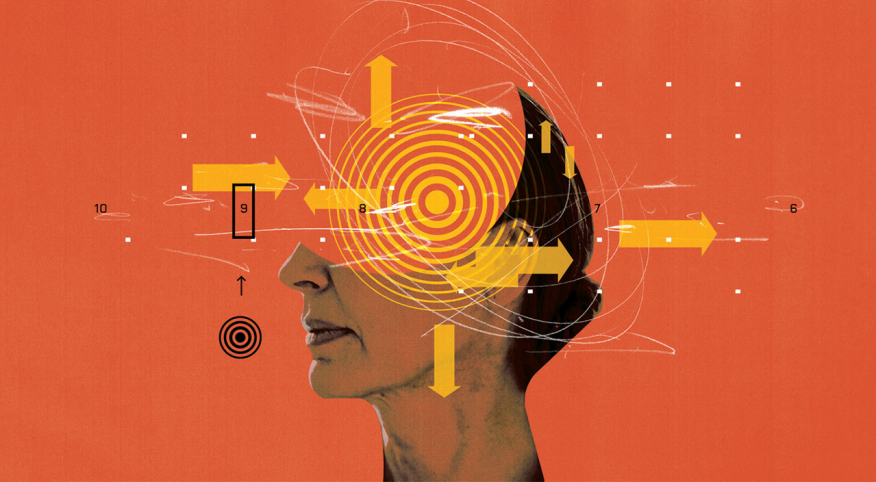Welcome to my brain. Brace yourself. It can be verrrrrry busy in here. Always jumping around. Bouncing from this topic to that subject. We’re out of bananas … did I take my baby aspirin … gotta do Wordle ... boy, do I need a pedicure.
A court reporter couldn’t keep up with what’s going on in here.
Toss in emails, breaking news headlines, Instagram and Facebook, and my head’s a regular Mount Vesuvius. If my brain could get a thought in edgewise, I’m sure it would scream: Hey! I’m exhausted! Can’t you slow things down and give me a break?
Well, Linda’s Brain — it’s not like I haven’t tried.
Mellow friend Jim Trowell is a huge fan of meditation. “My monkey brain never stops its chatter,” he says. “But observing my thoughts coming and going, being the observer, gives me some sense of control.”
I envy Jim. I envy anyone who can meditate. I can last two, three minutes tops. My niece Esther calms her mind with deep breathing. Me? I just end up hyperventilating. I’ve also tried mantras. Mine usually go like this: ohhhmm … ohhhmm … ohhhmm … myyyy … I … haaaate … this.
With many of the popular mindful pursuits not cutting it for me, I decided to learn something a little different: Self-hypnosis. If you’re immediately thinking Harry Houdini, let’s reintroduce the concept by a more modern name: practical neuroplasticity. That sounds far more distinguished, doesn’t it?
I started by contacting neuroplasticity specialist Melissa Tiers, founder of the Center for Integrative Hypnosis in New York. She’s traveled to places like Australia, Brazil, Switzerland and Dubai giving lectures and training professional practitioners, but now she was on my computer screen. Helping me. Via Zoom.
Her forte is anxiety — and fixing in a few sessions what otherwise might take years of talk therapy. She always begins by asking a client: “What do you want to change today?”
Spinning thoughts are a form of anxiety that create a habituated pattern in the brain. Practical neuroplasticity is a way of using your own mind to change your brain.
Research psychiatrist Jeffrey M. Schwartz, M.D., author of You Are Now Your Brain, first used brain scans more than 20 years ago to demonstrate the effectiveness of self-directed neuroplasticity. If I’d known that, my mind could have calmed down in 2002. As Schwartz writes in his book, “How you focus your attention influences your brain and how it is wired. This means that if you repeat the same act over and over regardless of whether that action has a positive or negative impact on you — you make the brain circuits associated with that act stronger and more powerful.”
OK, brain — listen up!
Tiers taught me some rapid techniques for quieting the mind. Ways to put my head in time-out. As someone who doesn’t even have patience for a mantra or two, the appealing word for me was: rapid. My favorite technique was one she calls “shift out and shut up.”
You stare straight ahead. Then — without moving your eyes — widen your peripheral vision on both sides. And continue to widen it. That’s all it takes to activate a relaxation response in your parasympathetic nervous system. I didn’t even know I had a parasympathetic nervous system. But already I was feeling more relaxed.
Another technique is to hold a set of keys or a small ball. Pretend there’s a meridian line going from your head to your feet right down your chest. Pass the keys from your right hand into your left hand. Then back and forth. Hello, left. Hello, right. Crossing that meridian line each time. This is called bilateral stimulation and it really does calm the mind. But now it was time for the good stuff. Going into a trance.
“The techniques can be just as powerful,” Tiers said. “But clients are always eager to get to the actual hypnotic session.”
I was nervous. But Tiers’ soothing voice and sure-footed confidence helped me relax. To kick things off, she had me close my eyes and visualize the number 10 while imagining a wave washing over me. Then she instructed me to let the 10 fade away and see the number 9 as a wave washed over me … then let the 9 fade away … and see the number 8 as a wave … and fade away. Are you still awake? Just typing these instructions is knocking me out.
How did it feel to be in trance? I was never “out of it” or unaware. It’s more like I was talking with someone while feeling drowsy. The way I felt in high school chemistry class. Or like when you’re in a movie theater, super focused, tuning out all the popcorn crunching and candy wrappers. Totally alert, but in a different zone.
Meanwhile, Tiers guidance conditioned in a new pattern that chatted with my brain to implement different strategies for staying focused. Even though I was always aware, I don’t remember everything. But there was something about me sitting at my computer, needing to focus, and how I should press my foot down — like it’s on a gas pedal. When my mind starts spinning, as soon as I feel the “pull,” I can press my foot on that “pedal” to restore focus.
Tiers later explained that this is a “kinesthetic anchor,” and I’m excited that my brain now has one. I’ve been tossing a lot of keys. Pressing my gas pedal. My brain has eased up on its constant bopping around.
Of course, as the world churns, nobody can avoid all the chaos going on outside our heads. But it’s comforting to have some strategies to manage inner mayhem. If virtual instructions on how to fall into a trance sounds too woo-woo for you, Tiers’ book The Anti-Anxiety Toolkit: Rapid Techniques to Rewire the Brain has easy directions for “shift out and shut up” and all its cousin techniques. You can also do an internet search for “neuroplasticity” and see what pops up.
It’s enough to make your head spin. My head, however, is feeling chill.
Anyone else ever try self-hypnosis? Let us know in the comments below.

Stuart Bradford
Follow Article Topics: Health





